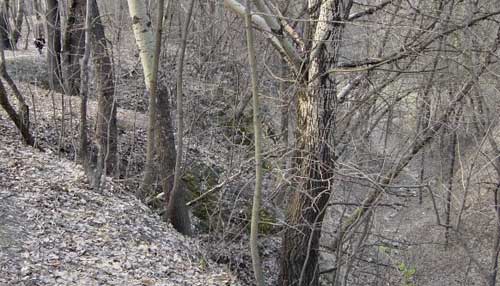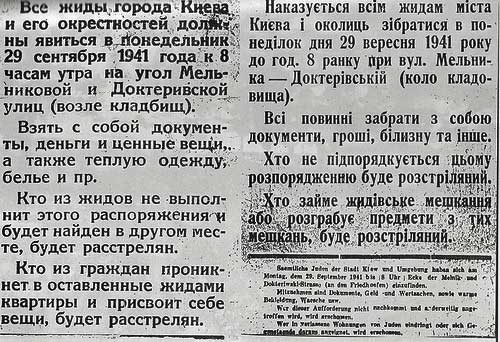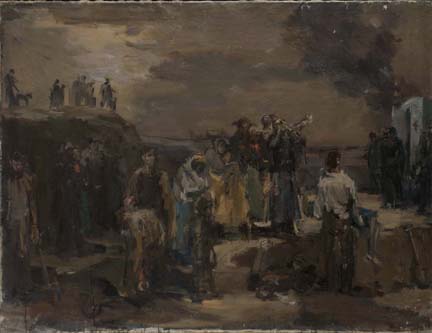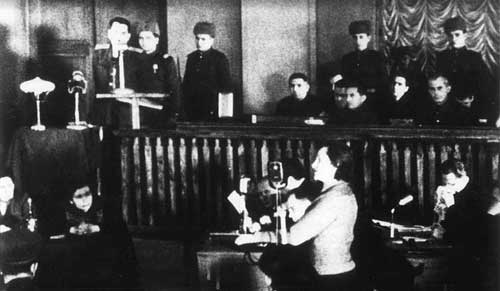This article is about a massacre of Jews and other murders during World War II. For the book by Anatoly Kuznetsov, see Babi Yar: A Document in the Form of a Novel. For the poem by Yevgeny Yevtushenko, see Babi Yar (poem). For the Shostakovich symphony based on the poem, see Symphony No. 13 (Shostakovich).
Babi Yar is a ravine in the Ukrainian capital Kiev and a site of a series of massacres carried out by the Nazis during their campaign against the Soviet Union. The most notorious and the best documented of these massacres took place on September 29–30, 1941, wherein 33,771 Jews were killed in a single operation. The decision to kill all the Jews in Kiev was made by the military governor, Major-General Kurt Eberhard, the Police Commander for Army Group South, SS-Obergruppenführer Friedrich Jeckeln, and the Einsatzgruppe C Commander Otto Rasch. It was carried out by Sonderkommando 4a soldiers, along with the aid of the SD and SS Police Battalions.
Other victims included thousands of Soviet POWs, communists, Gypsies (Romani people ), Ukrainian nationalists and civilian hostages. It is estimated that between 100,000 and 150,000 more lives were taken at Babi Yar.[1]
Historical background
The Babi Yar (Babyn Yar) ravine was first mentioned in historical accounts in 1401, in connection with its sale by “baba” (an old woman), the cantiniere, to the Dominican Monastery.[2] In the course of several centuries the site had been used for various purposes including military camps and at least two cemeteries, among them an Orthodox Christian cemetery and a Jewish cemetery. The latter was officially closed in 1937.
Handout dated September 28, 1941 in Russian, Ukrainian with German
translation ordering all Kievan Jews to assemble for the march to Babi Yar.
Massacres of 29–30 September 1941
Axis forces, mainly German, occupied Kiev on 19 September 1941. On September 26 Maj. Gen. Kurt Eberhard, the military governor, made the decision to exterminate the Jews of Kiev, claiming that it was in retaliation for guerrilla attacks against German troops.[3] and SS-Obergruppenführer Friedrich Jeckeln, the SS and Police Leader at Rear Headquarters Army Group South. Einsatzgruppe C carried out the Babi Yar massacre and a number of other mass atrocities in Ukraine during the summer and autumn of 1941. Its commander SS-Brigadefuhrer Dr. Otto Rasch and the officer commanding Sonderkommando 4a, SS-Standartenfuhrer Paul Blobel were at the September 26 meeting as well. An order was then posted in the town:
Kikes of the city of Kiev and vicinity! On Monday, September 29, you are to appear by 08:00 a.m. with your possessions, money, documents, valuables, and warm clothing at Dorogozhitskaya Street, next to the Jewish cemetery. Failure to appear is punishable by death.’
— Order posted in Kiev in Russian and Ukrainian, on or around September 26, 1941.[4]
On 29 and 30 September 1941, a special team of German SS troops supported by other German units and local collaborators murdered 33,771 Jewish civilians after taking them to the ravine.[5] [6] [7] [8]
The massacre to come would be the largest single mass killing for which the Nazi regime and its collaborators were responsible during its campaign against the Soviet Union [9] and is considered to be “the largest single massacre in the history of the Holocaust “.[10]
Babi Yar Monument in Kiev
The implementation of the order was entrusted to Sonderkommando 4a, commanded by Blobel, under the general command of Friedrich Jeckeln.[11] This unit consisted of SD and Sipo, the third company of the Special Duties Waffen-SS battalion, and a platoon of the 9th Police Battalion. Police Battalion 45, commanded by Major Besser, conducted the massacre, supported by members of a Waffen-SS battalion.
Afterwards, an official Nazi report described the means by which the people were induced to come to the killing site:
The difficulties resulting from such a large scale action – in particular concerning the seizure – were overcome in Kiev by requesting the Jewish population through wall posters to move. Although only a participation of approximately 5,000 to 6,000 Jews had been expected at first, more than 30,000 Jews arrived who, until the very moment of their execution, still believed in their resettlement, thanks to an extremely clever organization.[12]
On Monday the Jews of Kiev gathered by the cemetery, expecting to be loaded onto trains. The crowd was large enough that most of the men, women, and children could not have known what was happening until it was too late: by the time they heard the machine-gun fire, there was no chance to escape. All were driven down a corridor of soldiers, in groups of ten, and then shot. A truck driver described the scene:
[O]ne after the other, they had to remove their luggage, then their coats, shoes, and overgarments and also underwear … Once undressed, they were led into the ravine which was about 150 meters long and 30 meters wide and a good 15 meters deep … When they reached the bottom of the ravine they were seized by members of the Schutzpolizei and made to lie down on top of Jews who had already been shot … The corpses were literally in layers. A police marksman came along and shot each Jew in the neck with a submachine gun … I saw these marksmen stand on layers of corpses and shoot one after the other … The marksman would walk across the bodies of the executed Jews to the next Jew, who had meanwhile lain down, and shoot him.[4]
More than thirty thousand Kiev Jews gathered at the corner of the two streets and were escorted to the cemetery, expecting to be loaded onto trains for deportation. The commander of the Einsatzkommando reported two days later: “Because of ‘our special talent of organisation’, the Jews still believed to the very last moment before being murdered that indeed all that was happening was that they were being resettled.”[13] According to the testimony of a truck driver named Hofer, victims were ordered to undress and beaten if they resisted:
I watched what happened when the Jews – men, women, and children – arrived. The Ukrainians led them past a number of different places where one after the other they had to give up their luggage, then their coats, shoes and over-garments and also underwear. They also had to leave their valuables in a designated place. There was a special pile for each article of clothing. It all happened very quickly and anyone who hesitated was kicked or pushed by the Ukrainians to keep them moving.
— Statement of Truck-Driver Hofer describing the murder of Jews at Babi Yar[14]
All were driven in groups of ten down a corridor of SS soldiers, and then shot at the edge of the Babi Yar gorge. The crowd was large enough that most of the men, women, and children could not have known what was happening until it was too late: by the time they heard the gunfire, there was no chance to escape. In the evening, the Germans undermined the wall of the ravine and buried the people under the thick layers of earth.[13] According to the Einsatzgruppe’s Operational Situation Report, 33,771 Jews from Kiev and its suburbs were systematically shot dead by machine-gun fire at Babi Yar on September 29 and September 30, 1941.[15] The money, valuables, underwear, and clothing of the murdered victims were turned over to the local ethnic Germans and to the Nazi administration of the city.[16]
Survivors
One of the most often-cited parts of Anatoly Kuznetsov ‘s documentary novel Babi Yar is the testimony of Dina Pronicheva, an actress of the Kiev Puppet Theatre, and a survivor.[17] She was one of those ordered to march to the ravine, forced to undress, and then shot. Jumping before being shot and falling on other bodies, she played dead in a pile of corpses. She held perfectly still while the Nazis continued to shoot the wounded or gasping victims. Although the SS had covered the mass grave with earth, she eventually managed to climb through the soil and escape. Since it was dark, she had to avoid the flashlights of the Nazis finishing off the remaining victims still alive, wounded and gasping in the grave. She was one of the very few survivors of the massacre and later related her horrifying story to Kuznetsov.[18] At least three survivors are known[19] .[20]
Felix Lembersky. Execution: Babi Yar, ca. 1944-1952
In 2006, Yad Vashem and other Jewish organizations started a project to identify and name the Babi Yar victims, but so far only 10% have been identified. Yad Vashem has recorded the names of around 3,000 Jews killed at Babi Yar, as well as those of some 7,000 Jews from Kiev who were killed during the Holocaust.[21]
Further executions
In the months that followed, thousands more were seized and taken to Babi Yar where they were shot. It is estimated that more than 100,000 residents of Kiev of all ethnic groups,[22] [23] [24] [25] [26] mostly civilians, were murdered by the Nazis there during World War II.[5] [27] A concentration camp was also built in the area.
Mass executions at Babi Yar continued up until the German forces departed from Kiev. On January 10, 1942 about 100 sailors from a military flotilla were executed there. In addition, Babi Yar became a place of execution of residents of five Gypsy camps. According to various estimates,[according to whom? ] during 1941—1943 between 70,000- 200,000 Roma people were rounded up and murdered at Babi Yar.[citation needed ] Patients of the Ivan Pavlov Psychiatric Hospital were gassed and then dumped into the ravine. Thousands of other Ukrainians were killed at Babi Yar.[28] Among those murdered were 621 members of the Organization of Ukrainian Nationalists (OUN). Ukrainian poet and activist Olena Teliha and her husband, renowned bandurist Mykhailo Teliha, were murdered there on February 21, 1942.[29]
Felix Lembersky. Execution: Babi Yar, ca. 1944-1952
Numbers murdered
Estimates of the total number killed at Babi Yar during the Nazi occupation vary. In 1946, Soviet prosecutor L. N. Smirnov at the Nuremberg Trials claimed there were approximately 100,000 corpses lying in Babi Yar, using materials of the Extraordinary State Commission set out by the Soviets to investigate Nazi crimes after the liberation of Kiev in 1943.[27] [30] [31] [32] According to testimonies of workers forced to burn the bodies, the numbers range from 70,000 to 120,000.
In a recently published letter to Israeli journalist, writer, and translator Shlomo Even-Shoshan dated May 17, 1965, Anatoli Kuznetsov commented on the Babi Yar atrocity:
In the two years that followed, Russians, Ukrainians, Gypsies, and people of all nationalities were murdered in Babyn Yar. The belief that Babyn Yar is an exclusively Jewish grave is wrong… It is an international grave. Nobody will ever determine how many and what nationalities are buried there, because 90% of the corpses were burned, their ashes scattered in ravines and fields.[33]
For his war crimes Paul Blobel was sentenced to death by the Nuremberg Military Tribunal in the Einsatzgruppen Trial. He was hanged in June 1951.
Syrets concentration camp
In the course of the occupation, the Syrets concentration camp was set up in Babi Yar. Interned communists, Soviet POWs, and captured Soviet partisans were murdered there. On February 18, 1943, three Dynamo Kyiv football players who took part in the Match of Death with the German Luftwaffe team were also murdered in the camp. It is estimated that about 25,000 Ukrainians died in the Syrets camp.
Concealment of the crimes
Before the Nazis retreated from Kiev, they attempted to conceal their atrocities. Paul Blobel, who was in control of the mass murders in Babi Yar two years earlier, supervised the Sonderaktion 1005 in eliminating its traces. For six weeks from August to September 1943, more than 300 chained prisoners were forced to exhume and burn the corpses (using local headstones as bricks to build ovens) and scatter the ashes on farmland in the vicinity. To this day many Ukrainians will not eat cabbage grown on those farms.
Remembrance Main article: Babi Yar memorials
After the war, commemoration efforts encountered serious difficulty because of the policy of the Soviet Union. After the collapse of the Soviet Union, a number of memorials have been erected on the site and elsewhere. The events also formed a part of literature. Babi Yar is located in Kiev at the juncture of today’s Kurenivka, Lukianivka and Syrets neighborhoods, between Frunze, Melnykov and Olena Teliha streets and St. Cyril’s Monastery. After the Orange Revolution, President Viktor Yushchenko of Ukraine hosted a major commemoration of the 65th anniversary in 2006, attended by Presidents Moshe Katsav of Israel, Filip Vujanovic of Montenegro, Stjepan Mesic of Croatia, and Chief Rabbi of Tel Aviv Rabbi Yisrael Meir Lau. Rabbi Lau pointed out that if the world had reacted to the massacre of Babi Yar, perhaps the Holocaust might never have happened. Implying that Hitler was emboldened by this impunity, Lau speculated: “Maybe, say, this Babi Yar was also a test for Hitler. If on September 29 and September 30, 1941 Babi Yar may happen and the world did not react seriously, dramatically, abnormally, maybe this was a good test for him. So a few weeks later in January 1942, near Berlin in Wannsee, a convention can be held with a decision, a final solution to the Jewish problem………. Maybe if the very action had been a serious one, a dramatic one, in September 1941 here in Ukraine, the Wannsee Conference would have come to a different end, maybe“.[34] A message was also delivered on behalf of the Secretary-General of the United Nations,[35] by his representative, Francis Martin O’Donnell, who added a Hebrew prayer O’seh Shalom,[36] from the Mourners’ Kaddish.
In fiction
- The Babi Yar executions are described in detail in Jonathan Littell ‘s novel “Les Bienveillantes ” (in English, “The Kindly Ones “), where the main character, Dr. Aue, is one of the Nazi officers in charge.
- In Chapter 5 of his novel “The White Hotel “, D.M. Thomas vividly describes the whole episode and his main character, Lisa’s execution at Babi Yar. He describes Dina Pronicheva as “the only witness, the sole authority for what Lisa saw and felt”. However Lisa’s death is not recounted and, in Chapter 6, Lisa later arrives, still alive, in a reception camp in Israel.
- “The Survivor of Babi Yar” by Othniel J. Seiden c 1980 ISBN 937050-02-4 is an account of the title character as he escapes and forms a Jewish resistance group of some size and significance.
- “The Remnant – Jewish Resistance in WWII” by Othniel J. Seiden c 2010 ISBN: 0980194148 (Books To Believe In) also tells of the horrors of Babi Yar along with the stories of the Forest People of the Ukraine who made up much of the Jewish Resistance to the Nazis.
Mudslide
Babi Yar was also the site of a large mudslide in the spring of 1961. An earthen dam in the ravine had held loam pulp that had been pumped from the local brick factories for ten years without sufficient drainage. The dam collapsed after heavy rain, inundating the lower-lying Kurenivka neighborhood. The death toll was estimated to be between 500 and 2,000 people.
Source: Wikipedia







Artículos Relacionados: